Stay informed with our blog where we share the latest business trends and insights, right practices, and our thoughts on the ever changing market place.
What 2026 Will Remember About Your 2025 Finish

December Defines Leadership
December isn’t just about closing the books. It’s about how you close.
Your board won’t remember the details of your Q2 metrics. Your teams won’t recall every off-site slide. Your customers won’t think back on mid-year adjustments. But everyone will remember how you finished the year.
And here’s the hard truth: strategy is taught; execution isn’t. That’s why December separates organizations that talk strategy from those that deliver results.

The Strategic Planning Trap

November Is Planning Season
November is when executive teams huddle for annual strategic planning. Off-sites, board decks, vision statements: this is the season of bold ideas and polished PowerPoint slides.
But here’s the hard truth: strategy is taught; execution isn’t. And that’s why so many brilliant strategies collapse under their own weight within months of the new year.
At Line-of-Sight℠, we see it every year. Organizations invest enormous effort in creating strategy, but far too little in operationalizing it.

The Final Stretch is Here

As the calendar turns to October, leaders everywhere feel the same tension: Have we done enough? Will we finish the year strong?
The truth is that the final stretch isn’t about how bold your strategy was in January. It’s about how clearly you execute in October, November, and December. Year-end results are written now, not in your original plans, but in your ability to align, focus, and push through with clarity.
We’ve seen it time and again: organizations with similar strategies finish the year in very different places. The difference comes down to execution discipline.

The Fourth Quarter is Coming

As September hits full stride and Q4 looms just weeks away, executive teams across industries are asking: “Are we truly aligned to finish strong?”
At Line-of-Sight℠, we believe that the final stretch of the year isn’t just about execution; it’s about strategic clarity. And for one forward-thinking company we recently partnered with, the difference between a solid Q4 and a standout finish was a matter of strategic understanding.

Back to School, Back to Strategy

As summer winds down and backpacks fill with fresh notebooks, the familiar rhythm of "back to school" returns. But this season isn’t just for students. For organizations, August offers a natural inflection point: a moment to reset, refocus, and recommit to strategic priorities before the final quarter rush.
We see this time of year as an opportunity for every team to go "back to strategy."

Strategy Starts at Orientation

Strategy Starts at Orientation
At Line-of-Sight℠, we believe strategic execution doesn’t begin with an annual offsite or quarterly OKR review — it begins on day one. The moment a new employee walks through the door, they should be oriented not just to policies and processes, but to purpose. That’s because strategy, to be successful, must be lived and understood at every level of the organization, from leadership to the newest team member.

The Execution Gap Is Destroying Value - PE Firms Know It

The Execution Gap Is Destroying Value - PE Firms Know It
Ask any Private Equity partner what keeps them up at night post-close, and you’ll hear a common theme: execution risk. A shiny investment thesis and an aggressive growth plan mean nothing if the portfolio company can't get out of its own way to deliver. PE firms don’t just need strategy, they need execution muscle. That's why Line-of-Sight is becoming indispensable.
According to Fortune, 70% of CEO failures aren't due to bad strategies, they’re due to poor execution. The Line-of-Sight platform was built to systematically identify and close that gap. It doesn’t rely on platitudes or theoretical frameworks. It delivers hard-edged visibility into organizational execution health—and it does it in weeks, not months.

The Hidden Cost of Being Good Enough

“Good is the enemy of great.” – Jim Collins
In this automotive parts company, “good” wasn’t the problem — it was the plateau. Leadership wasn’t failing. Strategy wasn’t broken. Teams were engaged. Metrics were in place. But despite all that… something was holding the organization back from achieving greatness.

Making Strategy Stick: The Line-of-Sight℠ Advantage

Strategy Is Not the Problem — Execution Is
In today’s fast-paced business world, strategy alone isn’t enough. A great strategy can easily fall flat if the people responsible for executing it don’t understand it — or don’t believe in it. That’s where Line-of-Sight℠ shines.
When an industrial company recently called on Line-of-Sight Implementers to conduct an organizational health scan, they uncovered a familiar but fixable problem: solid strategic thinking was in place, but strategic understanding and leadership communication were falling short.

How One Company Elevated Its Organizational Health by 26 Points with Line-of-Sight℠

From Stuck to Scaling
This mid-sized enterprise faced challenges common in fast-growing organizations: siloed teams, unclear goals, inconsistent execution, and leadership fatigue. Despite a well-documented strategy, progress was slow. A Line-of-Sight diagnostic revealed the root issue: low organizational health.
With an OHI of 54%, the organization was underperforming across multiple dimensions. But with focus and the right support, change was possible.

Profitless Prosperity

The "One Ford" initiative, launched by CEO Alan Mulally in 2006, remains a powerful example of organizational transformation and strategy execution. Facing severe financial challenges, Ford implemented the "One Ford" strategy to unify global operations, streamline product development, and foster a cohesive corporate culture. This approach restructured regional units into a global functional model, reduced vehicle platforms, and emphasized collaborative behaviors. As a result, Ford achieved a remarkable turnaround, returning to profitability without government bailouts during the financial crisis.

Discover the Power of Self-Aware Leadership with Robert Courser on Business Confidential Now
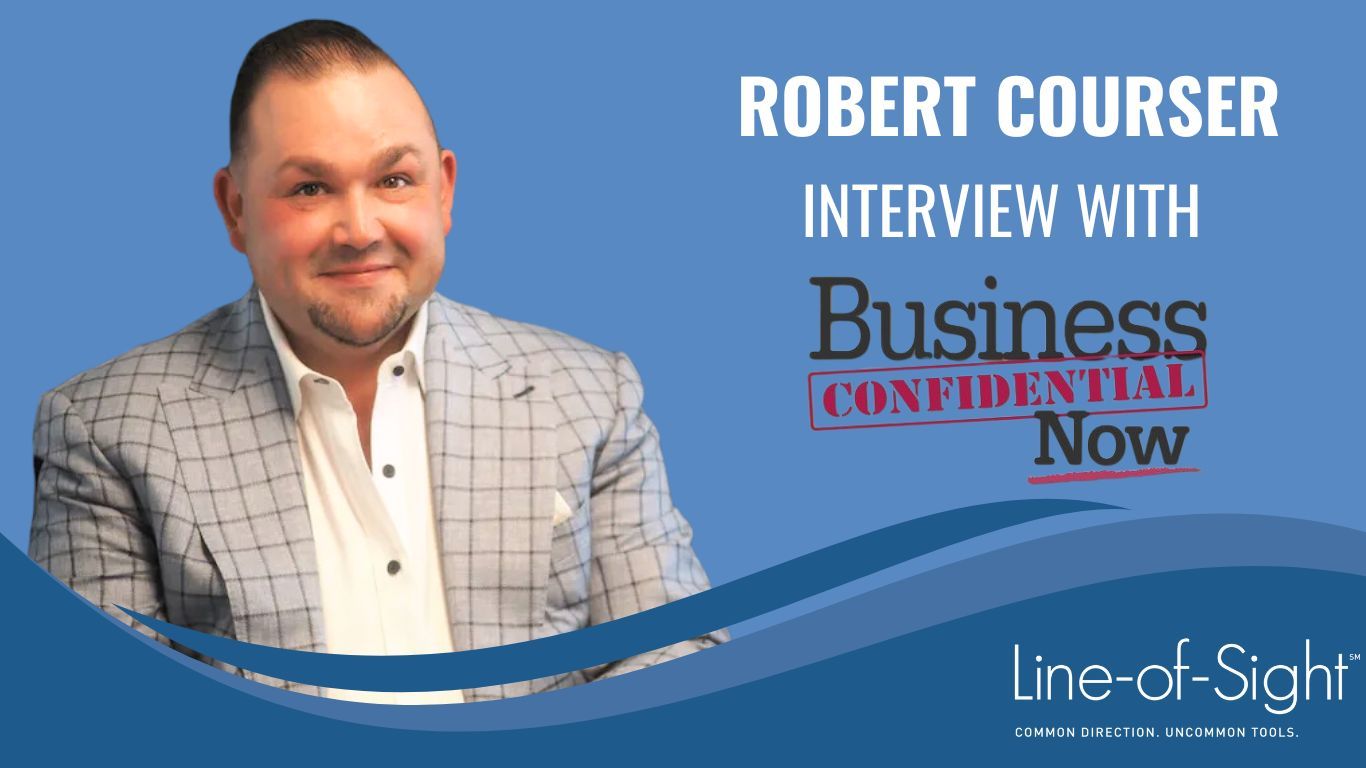
Our CEO, Robert Courser, was recently featured as a guest on the Business Confidential Now podcast. In this insightful episode, Robert dives into the importance of self-aware leadership and its critical role in strategic execution—a topic at the heart of his work and his latest book, Line of Sight: The Five Keys for Strategic Execution in an Age of Uncertainty.

Optimizing Human Capital with Line-of-Sight

In today’s business world, understanding human capital is key to unlocking an organization’s full potential. Success isn’t just about a solid strategy—it’s about ensuring that the people behind that strategy are fully aligned with the company’s goals.

Case Study: Transportation Company

A well-established, medium-sized trucking company with over 2,000 drivers had grown consistently over the past 20 years by establishing long-term relationships based on custom solutions for their customers. Budgets reflected their client intimacy go-to-market strategy; the CEO himself maintained well-established, long-term relationships with their largest customers. This strategy and market reputation always got them the last look in competitive bids with existing customers and new prospects.
When Line-of-SightSM was called, the CEO acknowledged that they had progressively lost that competitive edge in the last four years; they stopped being the partner of choice for their current customers, and equally concerning, they were not even getting invited to the table for new requests for proposals. The top line was flattening and increasing distrust in the leadership was pushing drivers to leave the organization in record numbers; their reputation as one of the best places to work in the industry was eroding, increasingly replaced by the perception of being a place that was hard on their employees. The CEO engaged with Line-of-SightSM to do an initial organizational health scan on the company.

Considering Becoming a LOS Implementer?

A few days ago, I sat down with the CEO and founder of a medical diagnostics company; they've reached a plateau in their growth and are now seeking a new operating model to scale up. As we were reviewing the data from their Line-of-Sight organizational health assessment, it became clear that their operational challenges would not go away without a rethink of their strategic positioning; currently, it just does not provide enough clarity on how they want to win in the marketplace, employees are confused, and the business is paying a hefty execution tax in the form of overworked employees, quality risks, and frustrated leadership.

Becoming a LOS Implementer - Testimony from Real Good Ventures

When we started Real Good Ventures we didn’t want to be a one-trick pony. We wanted to create a family of diagnostics that were complementary. The more we learned about LOS, the more it seemed like a great complement to our client approach. Turns out LOS is an incredible compliment to the other people and performance tools we use.

The Essence of Strategy Execution Series Insights from "Line of Sight": Leadership - The Catalyst for Execution
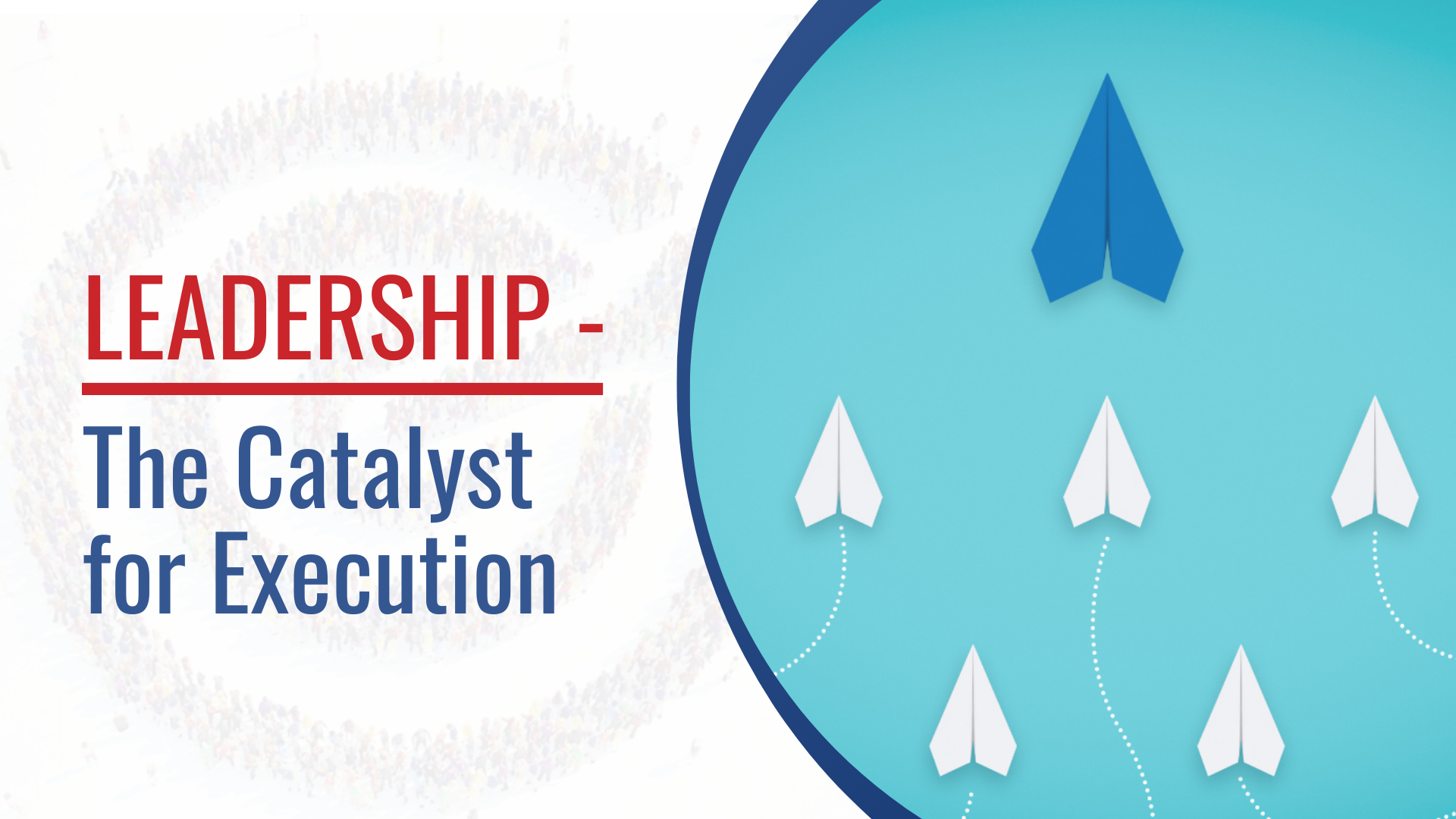
In our exploration of "Line of Sight" by Robert Courser and Olivier Aries, we now turn our attention to Chapter 6, which delves into the critical role of Leadership in strategy execution. This chapter underscores the necessity for leaders to be actively engaged in ensuring the strategy is understood, embraced, and acted upon by every member of the organization.

The Line of Sight: A Case Study

We recently worked with an aerospace company acting as a contractor for the US Department of Defense. The firm had grown opportunistically, adding many different lines of business, such as airplane maintenance, as demand arose alongside its original focus on drone operations. However, none of those activities could get enough resources and management attention to really thrive, and growth slowed to a halt.

Reflecting Mid-Flight: The Perfect Moment to Ponder Strategy Execution

Boeing's current turbulence shines a bright light on a pivotal lesson: the success of a strategy depends on the prowess of its execution.
Diving into this, let's apply the "Line of Sight" execution framework to decode Boeing's challenges. As someone deeply immersed in this topic (it's the focus of my latest book, after all!), I find the interplay between strategy and execution fascinating.

The Essence of Strategy Execution Series Insights from "Line of Sight”: Make It Clear, Make It Known
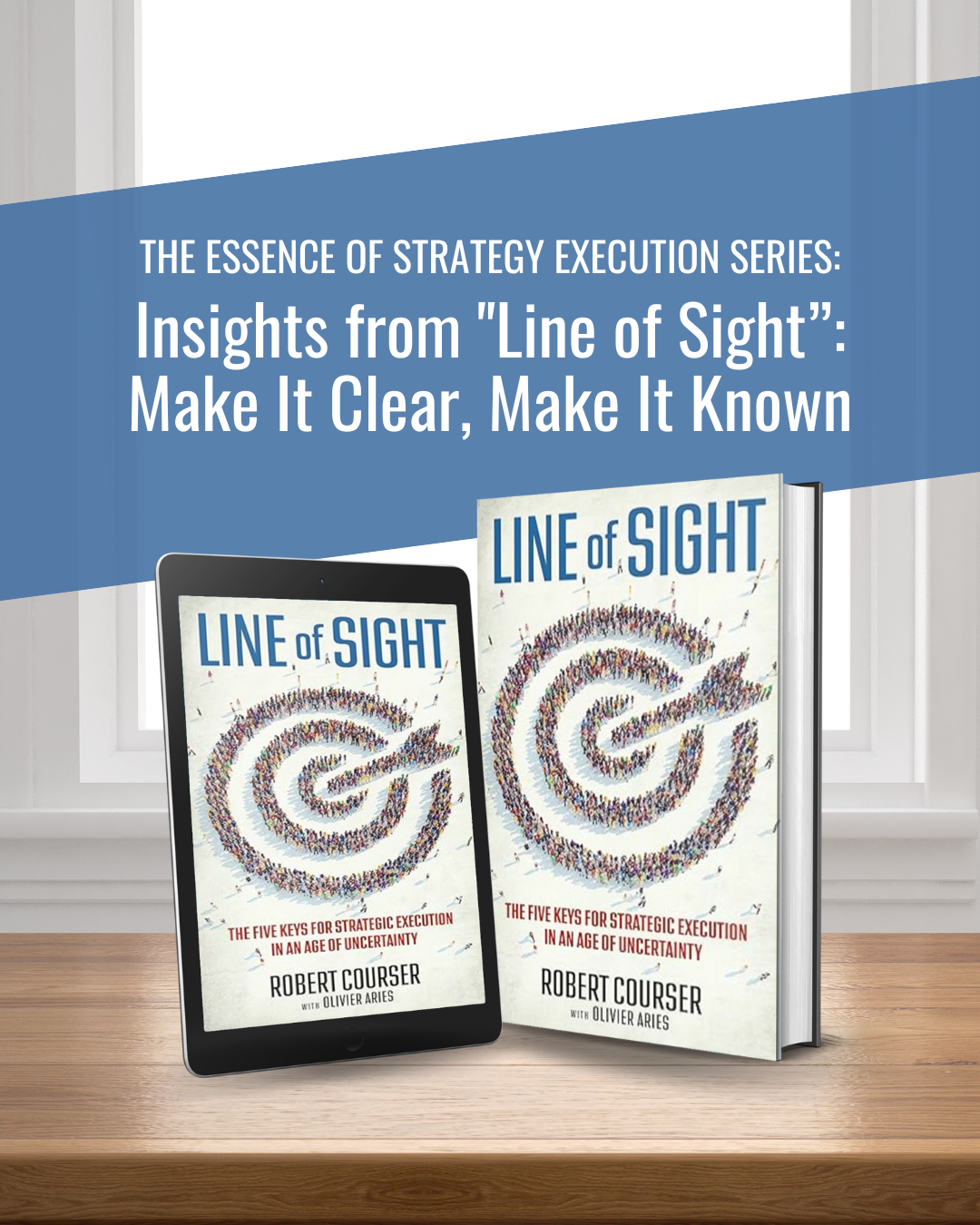
Diving into "Line of Sight" by Robert Courser and Olivier Aries, our focus shifts to Chapter 5, which hones in on the pivotal role of Strategic Understanding in the execution of a company's strategy. This chapter is essential, highlighting the critical need for every team member to grasp not only the broad strokes of the strategy but also their unique role in bringing it to life.

The Essence of Strategy Execution Series Insights from "Line of Sight”: The Five Keys for Strategic Execution
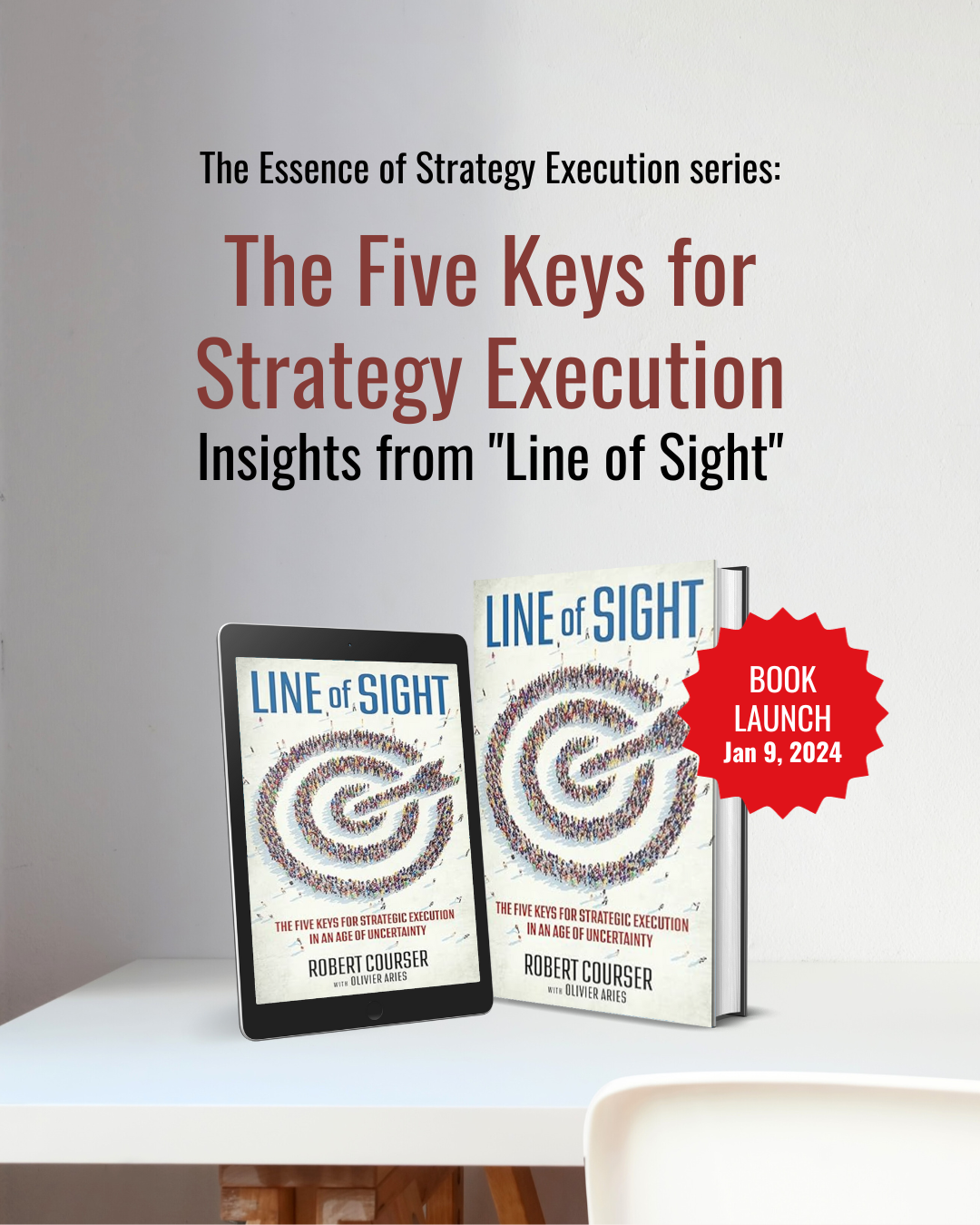
In our ongoing series delving into "Line of Sight," co-authored by Robert Courser and Olivier Aries, we now review a key section of the book: Chapter 4, which introduces the five keys for strategic execution; these are the five execution capabilities that determine the ability of an organization to align is resources to successfully meet its objectives.

The Essence of Strategy Execution Series Insights from "Line of Sight”: Crafting a Winning Strategy

As we continue our exploration of "Line of Sight," the upcoming book I am co-authoring with Olivier Aries, we delve into Chapter 3, which focuses on the core elements of an effective business strategy: mission, vision, strategic intent, and market discipline.

The Essence of Strategy Execution Series: Bridging Strategy and Execution - Insights from "Line of Sight"
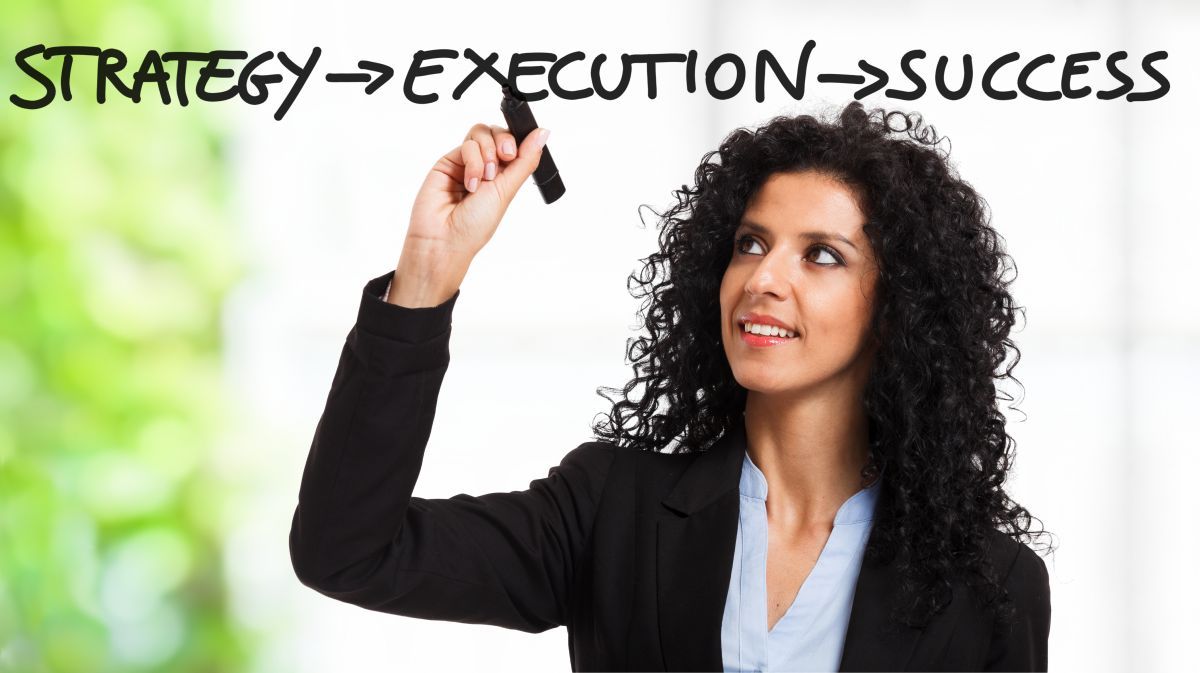
As we continue exploring key themes from our upcoming book, "Line of Sight," we are excited to dive deeper into the practical aspects of strategy execution. Launching in January 2024, this book aims to empower leaders with tools for effective strategy implementation.

The Essence of Strategy Execution Series: Introducing "Line of Sight"

We are thrilled to share insights from our upcoming book, "Line of Sight," launching in January 2024. This book is a culmination of our experiences and insights into strategy execution. As the book is being ready for publication, we could not wait to share the core concepts that drive effective strategy implementation in any organization.

Execution Courage

Our friends at McKinsey just published quite an interesting article on “Strategic courage in an age of volatility”.
This piece suggests that CxOs and business owners are adopting one of two attitudes in the face of the current uncertainty: either hunkering down and adopting a defensive posture or leaning into the volatility and “using it as a catalyst to galvanize action around new opportunities.”

Your Only Priority

In this blog we usually share our perspective on strategy execution based on our client work.
Today is different. We want to leave the stage to San Francisco-based Alpine Investments' CEO Graham Weaver.

OKRs and Execution

One of the keys to successful execution is to have clear metrics. We often think of metrics as a way to understand the health of the business, but an even more critical role for metrics is to guide employees’ behavior into doing the things that matter. Metrics should remove any ambiguity as to what needs to be done.

What is Your Reality?

Good execution is really about one thing: understanding the reality of your organization and making decisions based on facts.

When You Thought It Was Over

Just when we thought we had the pandemic under control and the economy was roaring back with tight employment, we must face a new reality: it isn’t over yet.

It's On the Leadership

Our Line-of-Sight colleagues recently organized a roundtable for senior executives on the topic of “Strategic and operational frameworks post-Covid.”
They were expecting to hear about increased digital delivery, sustainable supply chains, and emerging customer behaviors.
But something interesting happened: all that those leaders wanted to discuss was leadership and people. That was the only perspective that mattered to them when considering their strategies and operations.

The Two Numbers on Every Executive’s Mind

Today’s blog will be brief. Today, we are looking straight at reality. We are considering the two numbers that summarize the plight of most leaders: 90% and 95%.

Having your cake and eating it: When do you need a new structure to execute in the new normal?

If your company underwent drastic changes in its strategy or operating model during the past 2 years, you are not alone. Back in 2020, garment companies started to produce face masks, and appliance manufacturers churned out respirators. Not every CEO made such dramatic shifts in their operations, but many of us needed to re-orient our goals and execution to survive and thrive.

Culture and Strategy Are Two Sides of the Same Coin

If there is one positive consequence of the pandemic, it is how companies have become more thoughtful about their culture.
In the dark days of 2020, business owners and CEOs sought the right balance between empathy and expectation for performance, leading them to redefine their values and culture. And of course, a tight job market encouraged companies to be more explicit about their culture because candidates now seek greater purpose.

Your Strategy Will Help You Retain Employees if You Do This

You can boost your employees’ morale with a clear strategy. Clarifying your strategy and communicating it to employees can help them focus on the future, get a new sense of purpose, and focus on what matters.

The secret of execution is people. Ask these 1,700 executives.

In her groundbreaking study led by Harvard and Salesforce during the pandemic, famed innovation expert Linda Hill asked 1,700 executives: 97% said that their companies would not remain competitive unless they embarked on a digital transformation.

How to give your people essential direction--- without shutting them down

Among the five KSEs, the one with the broadest variation between CEOs is “activities and structure”, defined as the ability for an organization to focus employees on the tasks that matter the most to execute the strategy. CEOs who rate their execution capabilities the highest in this area lead organizations experiencing moderate growth (between +5 and +50%); on average they rate their capabilities on activities and structure at 78 points; compare that to CEOs of organizations that contracted (by 5% or more), at 59 points, and those of high-growth companies (growing 50% or more) at 63 points.

Make sure to answer these five questions when establishing your metrics

Selecting metrics is of paramount importance. Read on to see the five questions that you need to ask and answer when implementing a new set of metrics or evaluating an existing set.

Employee Burnout - Don’t Do it Again

In our always-on world, burnout has long been a reality. But in 2020 burnout and chronic stress became rampant as a third of U.S. employees started “living at work” and faced threats to their health, economic insecurity, and concerns for their loved ones. Burnout is more than just an employee problem; it is an organizational problem that requires an organizational solution.

Six leadership paradoxes for the post-pandemic era

It is naturally challenging to try and establish causality between a company's growth rate and how its executives rate their own leadership. But the humility displayed by CEOs of growing companies hints at what Paul Leinwand, the co-author of a recent HBR article, calls “the paradoxes of leadership in the post-pandemic era”.

Less is More: How to Select Strategic Initiatives that Create Value

In the post-pandemic, companies are restarting projects that got paused or side-tracked during the COVID crisis. But as employees are adjusting to being back in the office and consumer demand remains unpredictable, leaders should avoid the trap of doing too much, too soon.

Product or Service Innovation

The pandemic compelled many companies to rapidly pivot and develop new delivery models, products, or services to meet massive changes in customer behavior. So, we would expect many CEOs to continue to follow product innovation strategies in 2021; in fact, only about a quarter of them (24%) do; as we discuss in another article on market positioning, the majority of CEOs (50%) decided to pursue strategies based on customer intimacy. This makes a lot of sense: companies should be as attuned to demand shifts as possible in periods of high uncertainty, and this may inform the decision to innovate or not.

Operational Excellence

Line-Of-Sight was curious about the strategies CEOs are following as they navigate their way out of the pandemic. It turns out that only 21% of CEOs surveyed are following an operational excellence strategy. Operation excellence is a strategy aimed at delivering a combination of low price, ease, speed, hassle-free use, and convenience.

Customer Intimacy

Want to follow a Customer Intimacy-based strategy? This post tells you how you need to execute.

Human Capital: The Unsung Hero of Execution

Line-of-SightSM led a survey of more than 100 CEOs to measure how they evaluated the execution capabilities of their organization. This survey took place in Q1 2021, when most businesses were pivoting to take advantage of post-pandemic economic growth. The results indicate that among all five key execution success metrics, CEOs rate their capabilities related to human capital the lowest at 64, 7 points lower than the average organization health index at 71.

The Paradox of Size

In the first quarter of 2021, Line-of-SightSM conducted research to measure how CEOs evaluated their organizations’ execution performance. The research considered in particular whether large companies (more than 500 employees) had any execution advantage compared to small to midsize companies.

The High Growth Curse

CEOs of high-growth companies rate their performance lowest among their peers

Human Capital: Preparing for the Turnover Tsunami

Surveys show that between 25% and 50% of employees plan to look for a job this year and will do so as soon as the effects of the pandemic subside. Employers were experiencing high employee churn prior to the pandemic last spring, but since then, voluntary turnover reached its lowest level in nine years as employees hunkered down among high economic uncertainty. We now predict voluntary job-leaving will increase significantly in 2021 as employees resume the job searches they put off for the past year.

Uncertainty Is Not An Excuse

In 2021, executives are challenged to follow a clear strategic path: should they continue to contain cost at the expense of new products? Should they pivot to address new demand, without knowing if it will evaporate when things return to normal? How can they move in-person customer service excellence online?

Preparing Human Capital for Superlearning

This week, we consider how you can keep your employees’ competencies up to date despite the shifts in the work they’ve been asked to perform since the pandemic started.

A Simple Idea to Keep Employees Focused on What Matters

This week we discuss a simple approach to align activities and structure to your business strategy in the post-pandemic. Previously, we stressed this simple truth: execution is the sum of all the activities performed by your employees. In order to achieve your long-term goals, you need to be doing the right work.

When It comes to Metrics, Less is More

In 2020, the pandemic crisis brought to the forefront the importance of relevant dashboards. When everything goes well, executives can live with ill-fitted metrics, because they know their business intimately and can supplement incomplete or inadequate data by their own experience.

What Leader Do you Want to Be in 2021?

This week we discuss the execution data we have seen while working with clients during the pandemic. We are taking a look at leadership, and how executives can extend the positive attributes of their crisis management into the post-pandemic phase in 2021.

The Many Benefits of a Clear Strategy

Despite the amount of change companies have been subject to, and perhaps because of it, Line-of-SightSM data show that our clients have over-indexed on communicating their intent and goals to employees.

Executing In the Post Pandemic World: Market Discipline

Market discipline is the alignment of your processes, systems, and culture with your competitive strategy. Market discipline starts at the top: the leadership team must define the mission (why do customers buy from us versus the competition), vision (what needs to be done to deliver the value proposition), and strategic intent of the organization. Only then can processes, infrastructure, and assets be aligned.

Executing In the Post Pandemic World: Human Capital

You execute with people and through people. Employees are your most precious asset, but they are also the one asset over which you have the least control. Employees walk out of your facilities at the end of each workday and many of them have not even been physically in the office in the past 9 months. In addition, the pandemic created an unusual dynamic as voluntary turnover abated during 2020 and many employees hunkered down, so that we expect a massive talent exodus in 2021, once GDP growth is firmly established and changing jobs becomes less risky than it was last year. Even if you are the lucky recipient of that talent, this will raise your retention stake even higher: the crisis showed employees what good crisis leadership and a supportive culture looked like, and they will expect the same going forward even when the pandemic dissipates. So how will you retain your talent and ensure it drives your execution?

EXECUTING IN THE POST PANDEMIC WORLD: Balanced Metrics

A set of well-chosen metrics allows employees to understand exactly how their activities are going to be tracked and how their output will be aggregated into successful execution. In other words, good metrics will foster the right behaviors to execute.

Executing In the Post Pandemic World: Leadership

Execution excellence starts at the top. It is the leadership team’s responsibility to set the foundation of execution by formulating a clear market positioning, communicating it to all employees with credibility, deliberately and thoughtfully managing the changes required to maintain excellence in operations, and being self-aware enough to understand their own strengths and gaps to deliver against their strategic goals.

Executing In the Post Pandemic World: Activities & Structure

Execution is the sum of all the activities and tasks performed by your employees. This is where the rubber hits the road. These activities and tasks must be directly relevant to your strategy. On paper, your processes and roles may be finely tuned and exactly what you need to execute. In the reality of the field, the actual tasks that employees perform may be very different from what the management thinks is happening.

3 Tips to Become a Market Leader

Follow these three tips to help you become a market leader.

Executing In the Post Pandemic World: Strategic Understanding

What happens when True North is defined, but not communicated? Execution will suffer as employees perform their jobs based on different assumptions and goals. It is not uncommon for teams to pursue conflicting goals; sometimes, managers and employees form cliques that each defend a different belief about what the strategy should be, a recipe for a toxic culture. No organization is immune to this confusion. Learn why communicating True North to your employees matter.

You Don’t Have to Pivot in a Crisis

When Covid-19 burst upon the scene this past march, startup ventures faced dramatic shifts in markets and the importance of strategic agility became undeniable: If you wanted your venture to survive, let alone thrive, business experts almost universally advocated deep internal cuts accompanied by pivots to new markets and business models. However, many well-funded startups in hard-hit industries such as hospitality, travel, and furniture to name a few — shunned strategic agility (changing product-market fit) for stability and resolutely stayed the course with only minor tweaks.

The 4 Pillars of Sapient Leadership

A new version of leadership has emerged during the pandemic, Sapient Leadership. A Sapient Leader is characterized by being wise, sagacious, and discerning in navigating change while also being humane in the face of change that can often feel alien. In this post, we'll discuss the four pillars of Sapient Leadership.

Help Your People Grow Through Trauma

Values-based leadership and attention to the community are always smart, but now they are mandatory. Under so-called normal circumstances, teams that are clear on their purpose work harder, smarter, and more collaboratively. And when leaders exhibit empathy, their employees: feel safer, work more creatively, and perform better. The pain associated with these past few months has destabilized us, but it has also held up a mirror, stripping away comfort and routine and revealing who we truly are. The choices we make in this moment will shape who we are going forward— and what our organizations —will become. In times of trauma, these strategies can help organizations not merely survive, but build what we wish what had been there all along.

LOS Balanced Metrics

As the conditions around an organization, department, or function continue to change, organizations must be prepared to morph their performance measures. It’s set and reset, not set and forget. As many CEOs observe these days, the dynamics of their respective business operating environments are changing constantly in response to digital innovation, social media, and the emergence of Covid-19. It’s time to rethink how they develop their performance measures. Going forward you must look at performance as a two-way street and watch for the linkages between indicators and the impact of one upon another. And most importantly, be ready to adapt to rapidly changing circumstances.

Adapting to the New Reality

In times of crisis, it’s easy for organizations to default to old habits—but those are often the times in which new approaches are most valuable. As companies position themselves for the new normal, they cannot afford to be constrained by traditional information sources, business models, and capital allocation behaviors. Instead they must highlight anomalies and challenge mental models, revamp their business models, and invest their capital dynamically to not only survive the crisis but to thrive in the post-pandemic world.

6 ACTIONS TO BECOME A MORE RESILIENT COMPANY

In the midst of the current pandemic, we have all become much more painfully aware of the fragility of supply chains, health care, and other critical systems. Many CEO’s have announced their intention to rebuild their businesses more resiliently, but not many know exactly how to go about accomplishing this task. Very few business schools teach resilience, and today’s managerial toolkit is primarily focused on financial performance management. As a result, very few organizations are able to explicitly design for, measure, and manage resilience. In this post we discuss 6 actions a company can take to become more resilient.

Reskilling Employees Post COVID-19

Mercer’s 2020 Global Talent Trends Study reveals that current realities and unresolved debates are weighing us down, even as we clearly see a future full of opportunities emerging later in this new decade. The changes we are witnessing, brought about by uncertain times, are not only disrupting our present but will set the “new normal” for how we live, work, operate, and do business. Reskilling employees has become a vital part of the business agenda.

6 Hidden Barriers to Your Organization's Transformation

It’s an understatement to say the pandemic presents the biggest challenge institutions of all types have faced in decades. Leaders are in the process of reimagining their strategy and values in the context of the “new normal” that they are facing, requiring their organizations to fundamentally transform their systems of organizing, managing, and leading to enable effective execution of their new direction — and do so quickly! The author of this article who has considerable experience in both working and studying corporate transformations points out six common interrelated reasons that often lead to failures to transform. He refers to them as hidden barriers. Leaders often don’t know — or sometimes choose not to know — about the hidden barriers that stand in the way of their institution’s transformation. People often don’t speak up about these barriers, fearing career derailment and even firing (for example Boeing, Wells Fargo, Volkswagen, to name a few). This in turn makes it impossible for senior teams to learn about these barriers and to take corrective action.

How to Successfully Manage Change

Organizational change can be challenging. Follow these tips for successful change management.

Is Your Strategy Your Company’s Best Kept Secret?

If we were to ask your frontline employees to identify your business strategy, how many of them would know the answer?

How to Craft the Perfect Mission and Vision Statement

It is critical that an organization has both a strong mission statement and a strong vision statement.

New site!

The Line-of-Sight℠ is getting a new look today. We're excited to announce the new and improved thelineofsight.com website.

Featured Posts
- Back to School, Back to Strategy
- Case Study: Transportation Company
- Discover the Power of Self-Aware Leadership with Robert Courser on Business Confidential Now
- How One Company Elevated Its Organizational Health by 26 Points with Line-of-Sight℠
- Making Strategy Stick: The Line-of-Sight℠ Advantage
- Optimizing Human Capital with Line-of-Sight
- Profitless Prosperity
- Strategy Starts at Orientation
- The Execution Gap Is Destroying Value - PE Firms Know It
- The Final Stretch is Here
- The Fourth Quarter is Coming
- The Hidden Cost of Being Good Enough
- The High Growth Curse
- The Many Benefits of a Clear Strategy
- The Strategic Planning Trap
- The Two Numbers on Every Executive’s Mind
- What 2026 Will Remember About Your 2025 Finish